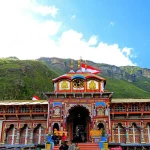Plan your sacred Do Dham Yatra 2025 to Kedarnath and Badrinath with our complete travel guide. Get route details, best time to visit, itinerary, travel tips, and more.
The Do Dham Yatra, covering the revered shrines of Badrinath and Kedarnath, is one of the most sought-after pilgrimage journeys in India. Every year, thousands of devotees make the spiritual trek to these sacred temples nestled in the rugged Himalayas, seeking blessings and peace. If you’re planning to embark on the Do Dham Yatra in 2025, this comprehensive guide will help you navigate everything you need to know, from the best time to visit to travel tips and essential bookings.
Do Dham Yatra 2025 Guide

Why Choose the Do Dham Yatra in 2025?
The Do Dham Yatra covers two of the most famous pilgrimage sites in India—Badrinath and Kedarnath. These temples are not only known for their religious significance but also for their breathtaking views and serene surroundings. By visiting these sacred shrines, you’re not only stepping into spiritual history but also immersing yourself in the natural beauty of the Himalayan mountains.
Here’s why you should consider the Do Dham Yatra in 2025:
- Religious Significance: Both temples hold a deep connection to Hindu mythology and provide an opportunity for spiritual growth and introspection.
- Scenic Beauty: The journey to Badrinath and Kedarnath is filled with majestic views of snow-capped peaks, dense forests, and alpine meadows.
- A Life-Changing Experience: The pilgrimage offers peace and clarity, helping you reconnect with yourself and your spiritual beliefs.
Best Time to Visit Badrinath and Kedarnath
To ensure you have the best experience during your Do Dham Yatra, it’s crucial to plan your trip around the best time to visit these locations. The ideal period is from May to October, when the weather is relatively pleasant, and the temples are open for pilgrims.
1. Summer (May – June)
- Weather: Pleasant, with temperatures ranging from 15°C to 20°C.
- Why Visit: The weather is ideal for trekking and sightseeing. Both temples are fully operational, and the roads are well-maintained.
2. Monsoon (July – September)
- Weather: Rainy season with risks of landslides and heavy rainfall.
- Why Avoid: The monsoon can make the trek challenging, and the risk of landslides on the mountain roads is high. Therefore, it’s not recommended to visit during this period.
3. Autumn (October)
- Weather: Crisp and cool, with temperatures ranging from 10°C to 15°C.
- Why Visit: This is one of the best times to visit as the weather is clear, and the views are spectacular. The temples begin to close for the winter season towards the end of the month.
Traveling to Badrinath and Kedarnath
Reaching Badrinath and Kedarnath involves traveling on challenging Himalayan roads, but modern amenities and various modes of transport can help make your journey more comfortable.
1. By Road
Both destinations are well-connected by motorable roads. You can take a bus, car, or taxi from major cities like Haridwar, Rishikesh, and Dehradun to reach Badrinath and Kedarnath.
- Badrinath: From Haridwar, you can reach Badrinath in about 10-12 hours by road.
- Kedarnath: Kedarnath is a bit more challenging to reach, as the temple is located at a high altitude. You’ll need to drive to Gaurikund (the last motorable point) and then trek to Kedarnath, which is around 16 kilometers.
2. Helicopter Services
For a more comfortable journey, especially to Kedarnath, you can opt for helicopter services. Several tour operators offer helicopter rides from Phata or Sersi to Kedarnath, cutting down on the physical effort involved in the trek.
3. By Train
The nearest railway stations to Badrinath and Kedarnath are Haridwar and Rishikesh, respectively. From there, you can easily find taxis or buses to reach your destination.
Accommodation Options
Accommodation near Badrinath and Kedarnath can vary from basic guesthouses to luxury hotels. Here’s what you can expect:
1. Badrinath
- Budget: Small guesthouses and lodges near the temple.
- Mid-range: Hotels offering basic amenities and comfortable rooms.
- Luxury: Some deluxe resorts offer a luxurious stay with beautiful views of the surroundings.
2. Kedarnath
- Budget: Simple accommodations such as dharamshalas (guest houses) and tented stays.
- Mid-range: Small hotels and campsites are available in Gaurikund and along the trekking route.
- Luxury: For a more comfortable stay, some operators offer helicopter packages that include stays in comfortable hotels near Kedarnath.
Trekking to Kedarnath
The trek to Kedarnath is a significant part of the journey and is an essential experience for many pilgrims. Here’s what you should know:
1. Distance and Difficulty
The trek from Gaurikund to Kedarnath is around 16 kilometers and takes 6–8 hours depending on your fitness level.
2. Trekking Tips
- Wear comfortable, sturdy footwear.
- Carry warm clothing, even in summer, as the temperatures drop significantly at night.
- Stay hydrated and take breaks regularly.
3. Pony and Palanquin Services
For those who can’t trek, ponies and palanquins (sedan chairs carried by porters) are available for hire to help you complete the journey.
What to Eat During the Yatra
While traveling to Badrinath and Kedarnath, food options are somewhat limited. However, you can find basic food stalls and restaurants along the way. Common options include:
- Prasadam: Offerings like prasad (holy food) are available at the temples.
- Vegetarian Meals: Due to the sacred nature of the Yatra, only vegetarian food is served. You’ll find simple meals like dal, roti, rice, and vegetables.
- Hot Beverages: Keep yourself warm with tea, coffee, and other hot drinks, especially in high-altitude areas.
Packing Tips for the Do Dham Yatra
Packing wisely is crucial for this challenging but spiritually rewarding journey. Here’s what you should bring:
1. Clothing
- Warm Clothes: Even in summer, the high-altitude areas can be cold, especially at night.
- Comfortable Footwear: A good pair of trekking shoes is essential for the journey to Kedarnath.
- Rain Gear: Carry a raincoat or umbrella as the weather can be unpredictable.
2. Medical Essentials
- First-aid kit: Include band-aids, painkillers, and any personal medications.
- Altitude Sickness Medication: If you’re trekking, carry altitude sickness tablets.
3. Other Essentials
- ID Proof: Carry valid identification for hotel check-ins and darshan.
- Camera: Don’t forget to capture the breathtaking views of the Himalayas.
Conclusion
The Do Dham Yatra to Badrinath and Kedarnath is a once-in-a-lifetime spiritual experience that offers peace, serenity, and a chance to connect with the divine. Planning your 2025 trip well in advance can ensure a smooth journey. From choosing the right time to visit to preparing for the trek, this guide has covered everything you need to know. May your pilgrimage be safe and filled with spiritual fulfillment.
FAQs
1. Can I do the Do Dham Yatra in a week?
Yes, the Do Dham Yatra can be completed in 7-8 days, depending on the time you spend at each temple and your mode of travel.
2. Are there any helicopter services to Kedarnath?
Yes, there are helicopter services available from Phata or Sersi to Kedarnath to save time and energy for the trek.
3. What is the best time to visit the Do Dham Yatra?
The best time is between May and October when the weather is favorable, and the temples are open to pilgrims.
4. Can I hire a pony for the Kedarnath trek?
Yes, ponies and palanquins are available for hire at Gaurikund for the Kedarnath trek.
5. How difficult is the Kedarnath trek?
The trek is challenging but manageable for most people with basic fitness levels. It’s about 16 kilometers one way and can be completed in 6-8 hours.





